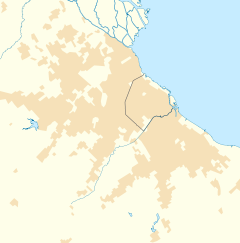
Berazategui is a partido in Buenos Aires Province, Argentina. With an area of 188 km2 (73 sq mi) and a population of 320,224, it is at the southeast of the Greater Buenos Aires urban conglomerate, and its capital is Berazategui city.
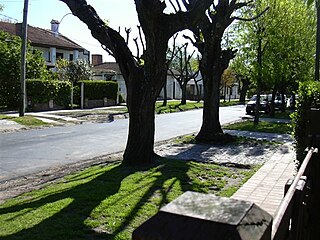
City Bell is a town located in La Plata Partido, Buenos Aires, Argentina. It is located some 10 kilometers from the city center. It forms part of the Greater La Plata urban agglomeration.

Ezeiza is the capital city of the Ezeiza Partido within the Greater Buenos Aires area in Argentina. The city had a population of 160,219 in 2010. Ezeiza is one of the fastest-growing cities in Argentina; the city and its surroundings are known for the many gated communities there, as well as for the Ministro Pistarini International Airport. Ezeiza and its surroundings is an affluent area where many well-to-do people live.

Caballito is a barrio (neighborhood) of the Argentine capital, Buenos Aires. It is the only barrio in the administrative division Comuna 6.

Pilar is a city in the province of Buenos Aires, Argentina with a population of 299,077 as per the 2010 census [INDEC]. It is part of the Greater Buenos Aires urban conurbation and is the seat of the administrative division of Pilar Partido. Since the early 1990s, Pilar has gained an increasingly upscale profile due to the development of numerous gated communities, country clubs and polo fields.

Necochea is a port and beach city in the southwest of Buenos Aires Province, Argentina. The city is located on the Atlantic coast, along the mouth of the Quequén Grande River, 528 km (328 mi) from Buenos Aires and 120 km (75 mi) southwest of Mar del Plata. The city proper has 90,000 inhabitants per the 2010 census [INDEC] and is the seat of government for Necochea Partido.
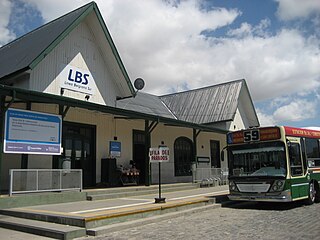
Buenos Aires is a former passenger railway station in the city of Buenos Aires, Argentina. The station was terminus of the Belgrano Sur line that runs trains along Greater Buenos Aires region.
English Argentines are citizens of Argentina or the children of Argentine citizens brought up in Argentina, who can claim ancestry originating in England. The English settlement in Argentina, took place in the period after Argentina's independence from Spain through the 19th century. Unlike many other waves of immigration to Argentina, English immigrants were not usually leaving England because of poverty or persecution, but went to Argentina as industrialists and major landowners. The United Kingdom had a strong economic influence in Argentina during the Victorian period. However the position of English Argentines was complicated when their economic influence was finally eroded by Juan Perón's nationalisation of many British-owned companies in the 1940s and then by the Falklands War in 1982. Notable Argentines such as Presidents of Argentina Raúl Alfonsín and Carlos Pellegrini, adventurer Lucas Bridges, Huracan football club former player and president Carlos Babington and writer Jorge Luis Borges are partially of English descent.

Tigre is a town in the Buenos Aires Province, Argentina, situated in the north of Greater Buenos Aires, 28 km (17 mi) north of Buenos Aires city. Tigre lies on the Paraná Delta and is a tourist and weekend destination, reachable by bus and train services, including the scenic Tren de la Costa. It is the principal town of the Tigre Partido.

Remedios de Escalada de San Martín is a city located in Buenos Aires Province, Argentina, within Lanús Partido, Gran Buenos Aires. It covers an area of 9,95 km² and the population was 81,465 in 2001; the demonym for its inhabitants is "escaladense."

San Miguel is a city in the northwest region of Greater Buenos Aires, 30 km from the City of Buenos Aires. San Miguel is the county seat of San Miguel Partido, and has been a part of Greater Buenos Aires since the early 2000s. The number of inhabitants was 157,532 according to the 2001 census.

Miramar is an Argentine city located on the coast of the Atlantic Ocean in Buenos Aires Province, 450 km (280 mi) south of Buenos Aires. It is the administrative seat of General Alvarado Partido. The name “Miramar” comes from the words mira (view) and mar (sea).

San Antonio de Padua, or plainly Padua, is a city in the Greater Buenos Aires, in Argentina. It is located in Merlo Partido. The city has an area of 6.25 km2 (2 sq mi) and a population of around 38,000.

Manuel B. Gonnet is a city in La Plata Partido, Argentina. It is part of a group of neighborhoods developed around the then Buenos Aires Great Southern Railway connecting La Plata with Buenos Aires, and Tolosa, Ringuelet, City Bell and Villa Elisa.
Asociación Deportiva Berazategui is an Argentine football club from the Berazategui district of Greater Buenos Aires. The team currently plays at the Primera C, the regionalised fourth division of Argentine football league system. Its Norman Lee Stadium has a capacity for 5,500 people.

The Central Argentine Railway (CA) was one of the Big Four broad gauge, 5 ft 6 in British companies that built and operated railway networks in Argentina. The company had been established in the 19th century, to serve the provinces of Santa Fe and Córdoba, in the east-central region of the country, although it would later extend its operations to Buenos Aires, Tucumán and Santiago del Estero.
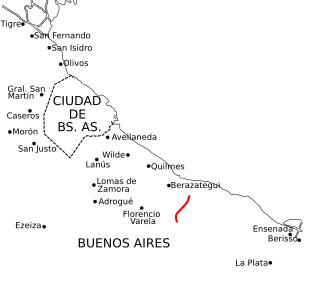
National Route A004 is a four-lane highway connecting National Route 1 at km marker 31 with the Juan María Gutiérrez circle in Greater Buenos Aires. The road extends for 8 km (5 mi), all within the limits of Berazategui Partido in Buenos Aires Province, Argentina.
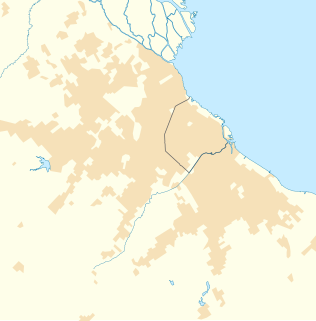
Isidro Casanova is a city in La Matanza Partido, Greater Buenos Aires, Argentina. It borders the towns of Villa Luzuriaga, San Justo, Ciudad Evita, Rafael Castillo, Laferrere, and Ezeiza.

The Roca line is a 1,676 mm gauge commuter rail service in the Buenos Aires Province, Argentina, part of General Roca Railway network. The service is currently operated by State-owned company Trenes Argentinos, from the city-centre terminus of Constitución south to Ezeiza, Alejandro Korn, La Plata, Cañuelas, Chascomús, Gutiérrez and Lobos, and west to Sarmiento Line's station Haedo. The transfer stations between the branch lines are Avellaneda, Temperley, Bosques and Berazategui.

Ciudad Madero, also known as Villa Eduardo Madero, is a city in La Matanza Partido, Buenos Aires Province, Argentina. It is located within the Greater Buenos Aires metropolitan area.

